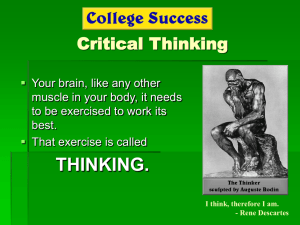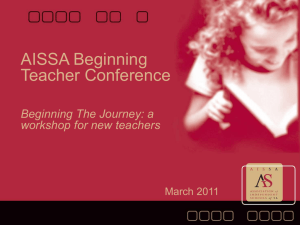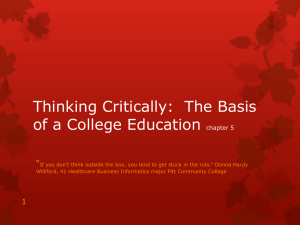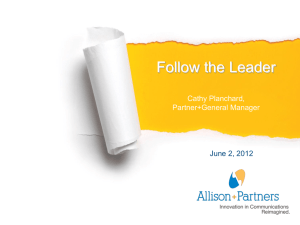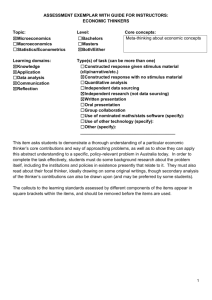Leadership Style Activity
advertisement
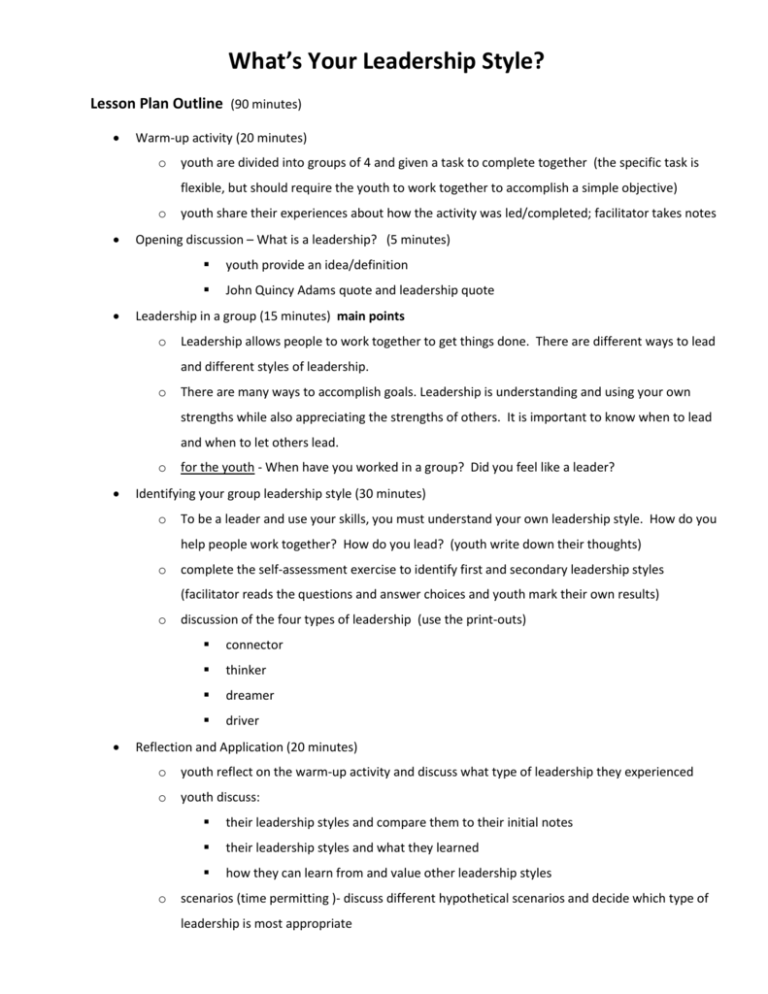
What’s Your Leadership Style? Lesson Plan Outline (90 minutes) Warm-up activity (20 minutes) o youth are divided into groups of 4 and given a task to complete together (the specific task is flexible, but should require the youth to work together to accomplish a simple objective) o youth share their experiences about how the activity was led/completed; facilitator takes notes Opening discussion – What is a leadership? (5 minutes) youth provide an idea/definition John Quincy Adams quote and leadership quote Leadership in a group (15 minutes) main points o Leadership allows people to work together to get things done. There are different ways to lead and different styles of leadership. o There are many ways to accomplish goals. Leadership is understanding and using your own strengths while also appreciating the strengths of others. It is important to know when to lead and when to let others lead. o for the youth - When have you worked in a group? Did you feel like a leader? Identifying your group leadership style (30 minutes) o To be a leader and use your skills, you must understand your own leadership style. How do you help people work together? How do you lead? (youth write down their thoughts) o complete the self-assessment exercise to identify first and secondary leadership styles (facilitator reads the questions and answer choices and youth mark their own results) o discussion of the four types of leadership (use the print-outs) connector thinker dreamer driver Reflection and Application (20 minutes) o youth reflect on the warm-up activity and discuss what type of leadership they experienced o youth discuss: o their leadership styles and compare them to their initial notes their leadership styles and what they learned how they can learn from and value other leadership styles scenarios (time permitting )- discuss different hypothetical scenarios and decide which type of leadership is most appropriate “If your actions inspire others to dream more, learn more, do more and become more, you are a leader.” John Quincy Adams Leadership is organizing a group of people to achieve a common goal. connector Do it together! _______________________________________________________________________________ social ; people-oriented ; democratic _______________________________________________________________________________ Connectors understand people and value relationships. They are good at motivating people to work together. Connectors are optimistic and good communicators. They like helping and teamwork. They do not give solutions but help others to find them. Connectors may also talk a lot and become easily distracted. They can be disorganized and allow relationships and fears to lead them away from good decisions. Strengths: Weaknesses: understands people strong values good at teamwork supportive listener focused on the present may have trouble saying no easily influenced by others avoids conflict easily distracted How to work with a connector: Let the person know you like him/her. Be fair and explain your actions. Value the relationship. Know that the person may have trouble saying “no” to you. Be positive and supportive. thinker Do it well! _______________________________________________________________________________ brainy ; quality-oriented ; bureaucratic _______________________________________________________________________________ Thinkers are smart and like to follow the rules. They like to have a lot of information and analyze situations. They like making plans and looking at the “big picture”. Thinkers ask “good” questions and pay attention to details. They like things to be done well and to be without mistakes. Thinkers may work very slowly and “think too much”. Sometimes they have trouble making decisions and worry a lot about how others view their work. Strengths: Weaknesses: explores all sides bases decisions on logic and data practical and thorough finds problems other may miss good at planning does not easily accept change works and act slowly may become lost in details may be too self-critical seems distant or withdrawn How to work with a thinker: Allow time for making decisions. Provide all information needed and available. Accept criticism. Use logical arguments. Follow the established rules and procedures. dreamer It is possible! _______________________________________________________________________________ creative ; idea-oriented ; hands-off _______________________________________________________________________________ Dreamers are “idea” people. They look at situations in new ways and find creative solutions. They think anything is possible. They allow the team to carry out their ideas freely, while helping from a distance. Dreamers inspire action. They let others do whatever seems best while watching from a distance. Dreamers often forget about details. They do not like to control others, so under their leadership team members may become distracted. Sometimes they focus on ideas that are unrealistic and impossible to achieve. Strengths: Weaknesses: creative and visionary thinks of things others do not appreciates a lot of information likes to explore new ideas optimistic and positive often loses focus may forget about details may forget to finish tasks may lose interest quickly does not follow timelines How to work with a dreamer: Show interest and excitement for their ideas. Listen and be patient. Do not be overly critical. Allow and support creative thoughts. Provide different types of tasks. Check the details. driver Just do it! _______________________________________________________________________________ eager ; goal-oriented ; autocratic _______________________________________________________________________________ Drivers like to give orders. They expect people to do what they say. They are direct, act quickly, and focus on results. They like to compete and want to win. They create change and are not afraid of conflict. They get things done. Drivers may be too aggressive and controlling. They are not patient and may make mistakes because they act too quickly. Strengths: Weaknesses: focused on the task keeps people on track enjoys challenge not afraid of problems or change likes to lead acts quickly and may make mistakes not patient may exclude others may not think of all the options controlling How to work with a driver: Share your ideas clearly and with confidence. Show the leader how to be involved. Talk about challenges and difficulties. Allow them to have control. Respect timelines. Give them positive public recognition. Self-Assessment Activity Ask youth to identify with two options for each question. They should keep a record of the letters they choose and tally them at the end of the activity 1. You would rather plan: a. a party b. a trip c. nothing d. a contest or competitive event 8. Your school notebooks are: a. like everyone else’s. b. very organized. c. full of drawings. d. good enough. 2. At a party, you: a. talk with everyone. b. mostly stay with your friends. c. are happy to be there. d. like everyone to know you are there. 9. When you start projects, you finish them: a. sometimes. b. always. c. when they are interesting to you. d. when you get to make the decisions. 3. People say you are good with: a. relationships. b. projects and school work. c. solving problems. d. getting people to follow you. 10. Your motto is: a. Do it together! b. Do it well! c. Anything is possible! d. Just do it! 4. People say you: a. talk a lot. b. think a lot. c. dream a lot. d. are confident. 11. People say you: a. are a good listener. b. are smart. c. are creative. d. are determined. 5. It is important for you to: a. be liked. b. be right. c. be free. d. be in charge. 12. You understand: a. people. b. systems. c. ideas. d. leadership. 6. The world would be better if everyone were: a. more friendly. b. more responsible. c. more positive. d. more active. 13. You make decisions: a. after talking to others. b. slowly. c. only when you have to. d. quickly. 7. People say you are: a. talkative. b. serious. c. open-minded. d. bossy. 14. You like to work in a team: a. all the time. b. when people understand their tasks. c. when the project is interesting. d. when you can be the leader. 15. You do not like: a. conflict. b. change. c. details. d. losing. 22. People say you are: a. nice. b. smart. c. interesting. d. funny. 16. People say you: a. avoid conflict. b. care about details. c. could create anything. d. like to win. 23. You would like to be: a. a psychologist or counselor. b. a professor. c. a designer. d. the boss of a large business. 17. In working with other, you like to : a. include everyone. b. make a plan. c. try new ideas. d. make decisions quickly. 24. You would like to be: a. a teacher. b. an engineer. c. a chef. d. an actor. 18. You would rather read: a. fantasy books. b. true stories. c. poetry. d. action books. 25. You like to help people: a. be friends. b. solve problems. c. act in new ways. d. do things. 19. You would rather be: a. with people. b. sure of what you are doing. c. free to change plans. d. in control. 26. If you have extra time at school, you: a. talk to people. b. finish your homework early. c. do something you enjoy. d. try to move around or go outside. 20. You like movies that make you: a. happy. b. think. c. feel. d. excited. 27. Rules should be followed: a. when they help people. b. all the time. c. when you feel like it. d. by other people. 21. Your favorite part of school is: a. talking to friends. b. learning the lessons. c. learning new ideas. d. free time outside. 28. You like to speak in public when: a. you can engage with people. b. you understand the topic and have time to prepare. c. you are interested in the topic. d. people are paying attention to you. 29. People say you: a. are good at teamwork. b. ask good questions. c. have good ideas. d. are good at making decisions. 34. You do not like to be: a. alone. b. wrong. c. bored. d. lazy. 30. In group work, you like when everyone: a. participates. b. does their work well. c. lets you do things the way you want. d. does what you say. 35. It is important that people a. like you. b. understand you. c. do not tell you what to think. d. listen to you. 31. Your friends are: a. numerous. b. few, but close. c. different from each other. d. competitive and playful. 36. When faced with a big challenge, you: a. ask others for advice. b. may become discouraged. c. think of new solutions. d. make a new plan easily. 32. You like your friends to: a. be near you. b. be honest with you. c. inspire you. d. challenge you. 37. You would be most sad to lose your: a. ability to talk. b. ability to see. c. ability to feel. d. ability to walk. 33. You would rather: a. go to a friend’s wedding. b. camp with a friend. c. paint with a friend. d. play soccer with a friend. 38. After making a mistake, it is important to: a. apologize. b. understand what you did wrong. c. try something else. d. forget about it. Scenarios Ask youth to determine which leadership style is most appropriate for the scenarios given below. Answer are flexible, but a suggestion is given in parentheses. 1. Making a movie: a. directing the actors (driver) b. organizing all the different groups of people working to make the movie (thinker) c. promoting the movie (connector) d. writing the script (dreamer) 2. In the classroom: a. painting a class portrait (dreamer) b. helping students escape from a fire (driver) c. planning a class party (connector) d. taking notes for absent students (thinker) 3. Traveling with friends: a. helping people agree on when and where to go (connector) b. suggesting where to go and what to do there (dreamer) c. arranging the travel schedule and making arrangements (thinker) d. dealing with the police if there is an accident or robbery (driver)
